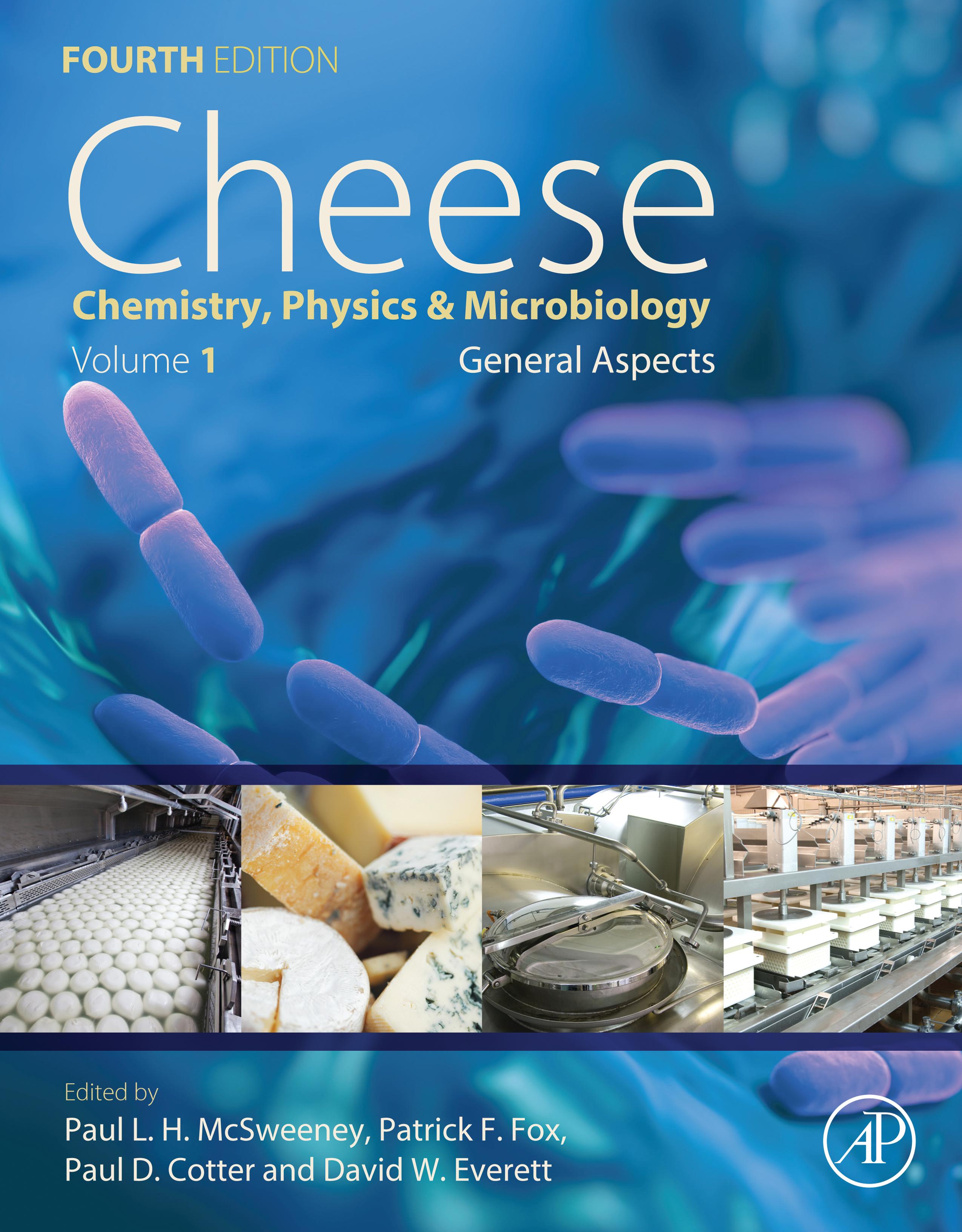Cheese
Chemistry, Physics & Microbiology
Fourth edition
Edited by
Paul L.H. McSweeney, Patrick F. Fox, Paul D. Cotter and David W. Everett
Academic Press is an imprint of Elsevier
125 London Wall, London EC2Y 5AS, United Kingdom
525 B Street, Suite 1800, San Diego, CA 92101-4495, United States
50 Hampshire Street, 5th Floor, Cambridge, MA 02139, United States
The Boulevard, Langford Lane, Kidlington, Oxford OX5 1GB, United Kingdom
Copyright © 2017 Elsevier Ltd. All rights reserved.
No part of this publication may be reproduced or transmitted in any form or by any means, electronic or mechanical, including photocopying, recording, or any information storage and retrieval system, without permission in writing from the publisher. Details on how to seek permission, further information about the Publisher’s permissions policies and our arrangements with organizations such as the Copyright Clearance Center and the Copyright Licensing Agency, can be found at our website: www.elsevier.com/permissions.
This book and the individual contributions contained in it are protected under copyright by the Publisher (other than as may be noted herein).
Notices
Knowledge and best practice in this field are constantly changing. As new research and experience broaden our understanding, changes in research methods, professional practices, or medical treatment may become necessary.
Practitioners and researchers must always rely on their own experience and knowledge in evaluating and using any information, methods, compounds, or experiments described herein. In using such information or methods they should be mindful of their own safety and the safety of others, including parties for whom they have a professional responsibility.
To the fullest extent of the law, neither the Publisher nor the authors, contributors, or editors, assume any liability for any injury and/or damage to persons or property as a matter of products liability, negligence or otherwise, or from any use or operation of any methods, products, instructions, or ideas contained in the material herein.
Library of Congress Cataloging-in-Publication Data
A catalog record for this book is available from the Library of Congress
British Library Cataloguing-in-Publication Data
A catalogue record for this book is available from the British Library
ISBN: 978-0-12-417012-4
For information on all Academic Press publications visit our website at https://www.elsevier.com/books-and-journals
Publisher: Nikki Levy
Acquisition Editor: Megan Ball
Editorial Project Manager: Billie Jean Fernandez
Production Project Manager: Caroline Johnson
Designer: Matthew Limbert
Typeset by Thomson Digital
5. Rennet-Induced Coagulation of Milk
David S. Horne, John A. Lucey
6. The Syneresis of Rennet-Coagulated Curd
Colette C. Fagan, Donal J. O’Callaghan, Maria J. Mateo, Petr Dejmek
Section III
8. St arter Cultures: General Aspects
Eugenio Parente, Timothy M. Cogan, Ian B. Powell
9. Genet ics of Lactic Acid Bacteria
7. Formation, Structural Properties, and Rheology of Acid-Coagulated Milk Gels
John A. Lucey
10. Bacteriophages Infecting Lactic Acid Bacteria
James Murphy, Jennifer Mahony, Gerald F. Fitzgerald, Douwe van Sinderen
11. Secondar y and Adjunct Cultures
Françoise Irlinger, Sandra Helinck, Jean Luc Jany
12. Microbiota of Raw Milk and Raw Milk Cheeses
Orla O’Sullivan, Paul D. Cotter
13. Salt in Cheese: Physical, Chemical and Biological Aspects
Timothy P. Guinee, Patrick F. Fox
14. Biochemistr y of Cheese Ripening:
Paul L.H. McSweeney
15. Microbiome Changes During Ripening
Paul D. Cotter, Tom P. Beresford
Study Microorganisms
and Population Dynamics
16. Met abolism of Residual Lactose and of Lactate and Citrate
Paul L.H. McSweeney, Patrick F. Fox, Felicia Ciocia
Metabolism of Lactose in Cheese 411
to Lactate During Ripening
17. Lipolysis and Met abolism of Fatty Acids in Cheese
Anne Thierry, Yvonne F. Collins, M.C. Abeijón Mukdsi, Paul L.H. McSweeney, Martin G. Wilkinson, Henri E. Spinnler
Agents in Cheese
of Fatty Acids
Contribution of Free Fatty Acids and Their Derived Products to Cheese Flavor
18. Biochemistr y of Cheese Ripening: Proteolysis
Ylva Ardö, Paul L.H. McSweeney, Abdallah A.A. Magboul, Vivek K. Upadhyay, Patrick F. Fox
Proteolysis in Cheese During Ripening 464
19. Amino Acid Catabolism and Its Relationship to Cheese Flavor Outcomes
Balasubramanian Ganesan, Bart C. Weimer
Introduction 483
Compounds Associated with Flavor of Different Cheeses 483
Bacteria Associated with Cheese Flavor 489
Amino Acid Metabolism Observed in Cheese 494
Genomics of Lactic Acid Bacteria and Metabolism of Amino Acids 504
Summary of Current Status and Pitfalls 510
The Future of Bacterial Metabolism of Amino Acids in Cheese: Possibility of a Quantum Leap?
20. Sensor y Character of Cheese and Its Evaluation
Mar y A. Drake, Conor M. Delahunty
Introduction 517
A Definition of Sensory Character 517
Sensory Characteristics and Cheese
Cheesemaking and the Variety of Sensory
The Human Senses and the Sensory Properties of Cheese 525
Sensory Methods Used to Evaluate Cheese 527
Influence of Cheesemaking Variables on Sensory Character 537
Toward a Universal Cheese Sensory
Relating Sensory Characteristics to Consumer
Relating Sensory Perception to Chemical Components and Instrumental
21. Cheese Microstructure
David W. Everett, Mark A.E. Auty
Section V
Public Health Aspects
22. Growth and Survival of Microbial Pathogens in Cheese
Dennis J. D’Amico, Catherine W. Donnelly
23. Mycotoxins in Cheese
Alan D.W. Dobson
24. Nutritional Aspects of Cheese
Nora M. O’Brien, Thomas P. O’Connor
Lipolysis 916
Flavors 917
Catabolism of Amino Acid Side Chain 920
Miscellaneous Compounds 922
Texture 923
Control of Ripening 924
Conclusions 925
References 925
37. Blue Cheese
Mette Dines Cantor, Tatjana van den Tempel, Tine Kronborg Hansen, Ylva Ardö
Introduction 929
Microenvironment in Blue Cheese 929
Microorganisms that Contribute to Ripening of Blue Cheese 933
Microbial Interactions 939
Ripening of Blue Cheese 940
Selection of Cultures 947
Conclusions 948
References 949
38. Smear-Ripened Cheeses
Jérôme Mounier, Monika Coton, Françoise Irlinger, Sophie Landaud, Pascal Bonnarme
Introduction 955
Factors that Affect Ripening of Smear Cheeses 955
Microbial Diversity in the Smear 957
Genomic Features and Functions of the Cheese-Surface Microbiota 969
Sources of Microorganisms Composing the Cheese-Surface Microbiota 974
Pathogenic and Spoilage Microorganisms of Smear-Ripened Cheeses 976
Interactions Between the Cheese-Surface Microbiota 982
Control of Pathogens in Smear-Ripened Cheeses 983
Conclusions 986
References 986
39. Cheese Varieties Ripened Under Brine
A. Adnan Hayaloglu
Introduction 997
Definition 997
Why Brine Immersion Method in Cheese? 997
Cheesemaking Technology in Brine-Ripened Cheeses 999
Members of Brined-Cheese Family 999
References 1035
40. Pasta-Filata Cheeses
Donald J. McMahon, Craig J. Oberg
Introduction 1041 Overview of Manufacturing Technology 1041 Steps in Cheese Manufacture 1046
1054
Cheese Microbiology 1054
Cheese Chemistry 1056
Cheese Functionality 1059
References 1063
41. Cheeses From Ewe and Goat Milk
M. Medina, M. Nuñez
Ewe Milk Cheeses 1069
Goat Milk Cheeses 1078
Conclusions 1084 References 1084
42. Buffalo Milk Cheese
Sumit Arora, Yogesh Khetra
Introduction 1093
Chemistry of Buffalo Milk 1093
Buffalo Milk Cheeses 1095
Buffalo Milk Cheddar Cheese 1098
Technological Interventions to Enhance the Quality of Buffalo Milk Cheese 1099 Conclusions 1100
References 1100
43. Quark, Quark-like Products, and Concentrated Yogurts
Nana Y. Farkye
Introduction 1103
Traditional Quark Manufacturing Process 1103
Heat Treatment of Milk 1103
Acidification and Gelation 1103
Whey Separation 1104
Yield and Composition of Quark 1105
Quark Manufacture Using the Centri-Whey, Thermo, and UF Processes 1105
Separator Process 1105
Thermoquark Process 1107
Membrane Filtration 1107
Mechanism of Acid Gelation of Milk 1107
Storage and Shelf Life 1108
Addition of Stabilizers 1108
Buttermilk Quark 1108
Other Quark-Like Products 1108
Traditional Process (Cloth Bag Method) 1108
Mechanical Separators 1109
Production of Concentrated Yogurt by Ultrafiltration (UF) 1109
Concentrated Yogurt by Recombined Dairy Ingredients 1109
Composition of Concentrated Yogurts 1109
Novel Technologies 1109
Shelf Life 1110 References 1110
44.
Acid-Heat Coagulated
Cheeses
Nana Y. Farkye
Introduction 1111
Types of Acid/Heat-Coagulated Cheeses 1111
Manufacture of Queso Blanco and Paneer 1111
Paneer 1112
Ricotta 1113 References 1114
45. Brown Whey Cheese
Siv Skeie, Roger K. Abrahamsen
1117
1117
of Brown Whey Cheese 1117
1121
Background 1121
1122
1127 Crystallization of Lactose 1128
Effect of Milk and Whey Composition and Quality on Brown Whey Cheese 1130 Fortification of the Cheese With Iron 1132
1132
46. Pasteurized Processed and Imitation
Cheese Products
Timothy P. Guinee
1133
of Processed Cheese Products 1134
of Processed Cheese Products 1136
Protocol for Processed
1137 Principles of Manufacture of Processed Cheese Products 1140
Importance of Emulsifying Salts Properties in Cheese Processing 1146
Effect of Formulation Ingredients on the Consistency and Cooking Characteristics of Processed Cheese Products and Analog Cheese Products 1153
Effect of Processing Conditions on the Characteristics of Processed Cheese Products and Analog Cheese Products 1165
Parameters 1168
Salt-Free or -Reduced Processed Cheese Products 1169
and Substitute Cheese Products 1171
1176
1177
Thomas P. O’Connor, University College Cork, Cork, Ireland
Orla O’Sullivan, Teagasc Food Research Centre, Moorepark, Fermoy, Co. Cork; APC Microbiome Institute, University College Cork, Cork, Ireland
Craig J. Oberg, Weber State University, Ogden, UT, United States
Lydia Ong, The ARC Dairy Innovation Hub, The University of Melbourne; Bio21 Molecular Science and Biotechnology Institute, The University of Melbourne, Melbourne, VIC, Australia
Giorgio Ottogalli, Sezione di Microbiologia Agraria, University of Milan, Milan, Italy
Ram R. Panthi, Teagasc Food Research Centre, Moorepark, Fermoy, Co. Cork, Ireland
Eugenio Parente, University of Basilicata, Potenza, Italy
Ian B. Powell, Dairy Innovation Australia Limited (DIAL), Werribee, VIC, Australia
Harald Rohm, Institute of Natural Materials Technology, Technische Universität Dresden, Dresden, Germany
Prabandha K. Samal, Fonterra Research and Development Centre (Formerly known as New Zealand Dairy Research Institute), Palmerston North, New Zealand
J.J. (Diarmuid) Sheehan, Teagasc Food Research Centre, Moorepark, Fermoy, Co. Cork, Ireland
Siv Skeie, Norwegian University of Life Sciences, Ås, Norway
Henri E. Spinnler, INRA, Agro-Paris Tech, Paris, France
Henry-Eric Spinnler, AgroParisTech, Thiverval Grignon, France
Anne Thierry, UMR1253 Science and Technology of Milk and Egg, INRA, Agrocampus Ouest, Rennes, France
Meral Turgay, Agroscope, Bern, Switzerland
Therese Uniacke-Lowe, School of Food and Nutritional Sciences, University College Cork, Cork, Ireland
Vivek K. Upadhyay, School of Food and Nutritional Sciences, University College Cork, Cork, Ireland
Tatjana van den Tempel, DSM Food Specialities, Delft, The Netherlands
Douwe van Sinderen, University College Cork, Cork, Ireland
Daniel Wechsler, Agroscope, Bern, Switzerland
Bart C. Weimer, University of California, Davis, CA, United States
Martin G. Wilkinson, University of Limerick, Limerick, Ireland
Page left intentionally blank
Page left intentionally blank








